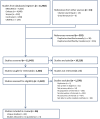Risk period for transmission of SARS-CoV-2 and seasonal influenza: a rapid review
- PMID: 39989317
- PMCID: PMC11883656
- DOI: 10.1017/ice.2025.11
Risk period for transmission of SARS-CoV-2 and seasonal influenza: a rapid review
Abstract
Background: Restricting infectious healthcare workers (HCWs) from the workplace is an important infection prevention strategy. The duration of viral shedding or symptoms are often used as proxies for the infectious period in adults but may not accurately estimate it.
Objective: To determine the risk period for transmission among previously healthy adults infected with SARS-CoV-2 omicron variant (omicron) or influenza A (influenza) by examining the duration of shedding and symptoms, and day of symptom onset in secondary cases of transmission pairs.
Design: Rapid review.
Methods: This rapid review adhered to PRISMA-ScR; five databases were searched. The cumulative daily proportion of participants with an outcome of interest was calculated for each study and summarized.
Results: Forty-three studies were included. Shedding resolved among ≥ 70% of participants by the end of day nine post symptom onset for omicron, and day seven for influenza; and for ≥ 90% of participants, by the end of day 10 for omicron and day nine for influenza. Two studies suggested shedding continues > 24 hours post-fever resolution for both viruses. Symptom onset occurred in ≥ 80% of secondary cases by the end of day seven post-primary case symptom onset for omicron and day six for influenza.
Conclusions: Omicron shedding is consistent with previous recommendations to exclude infected HCWs from work for 10 days; and influenza follows a similar trend. Earlier symptom onset in most secondary cases for both pathogens indicates that, despite persistent viral shedding, most transmission occurs earlier; and the cumulative serial interval might better approximate the duration of infectiousness.
Keywords: Influenza; Omicron; Rapid review; Respiratory illness; Serial interval; Shedding; Symptomatic infectious period; Symptoms; Viral.
Conflict of interest statement
The authors report that they have no conflicts of interest.
Figures




References
-
- Centers for Disease Control and Prevention. Infection Prevention and Control Strategies for Seasonal Influenza in Healthcare Settings. https://www.cdc.gov/flu/hcp/infection-control/healthcare-settings.html. Published 2021. Accessed February 12, 2025.
-
- Centers for Disease Control and Prevention. Interim Guidance for Managing Healthcare Personnel with SARS-CoV-2 Infection or Exposure to SARS-CoV-2. https://www.cdc.gov/covid/hcp/infection-control/guidance-risk-assesment-.... Published 2024. Accessed February 12, 2025.
-
- Kuhar DT, Babcock H, Brown VM, et al. Infection Control in Healthcare Personnel: Epidemiology and Control of Selected Infections Transmitted Among Healthcare Personnel and Patients. https://www.cdc.gov/infection-control/hcp/healthcare-personnel-epidemiol.... Published 2024. Accessed February 12, 2025.
-
- Kane RL, Shamliyan TA, Mueller C, Duval S, Wilt TJ. The association of registered nurse staffing levels and patient outcomes: systematic review and meta-analysis. Med Care 2007;45:1195–1204. - PubMed
Publication types
LinkOut - more resources
Full Text Sources
Miscellaneous

